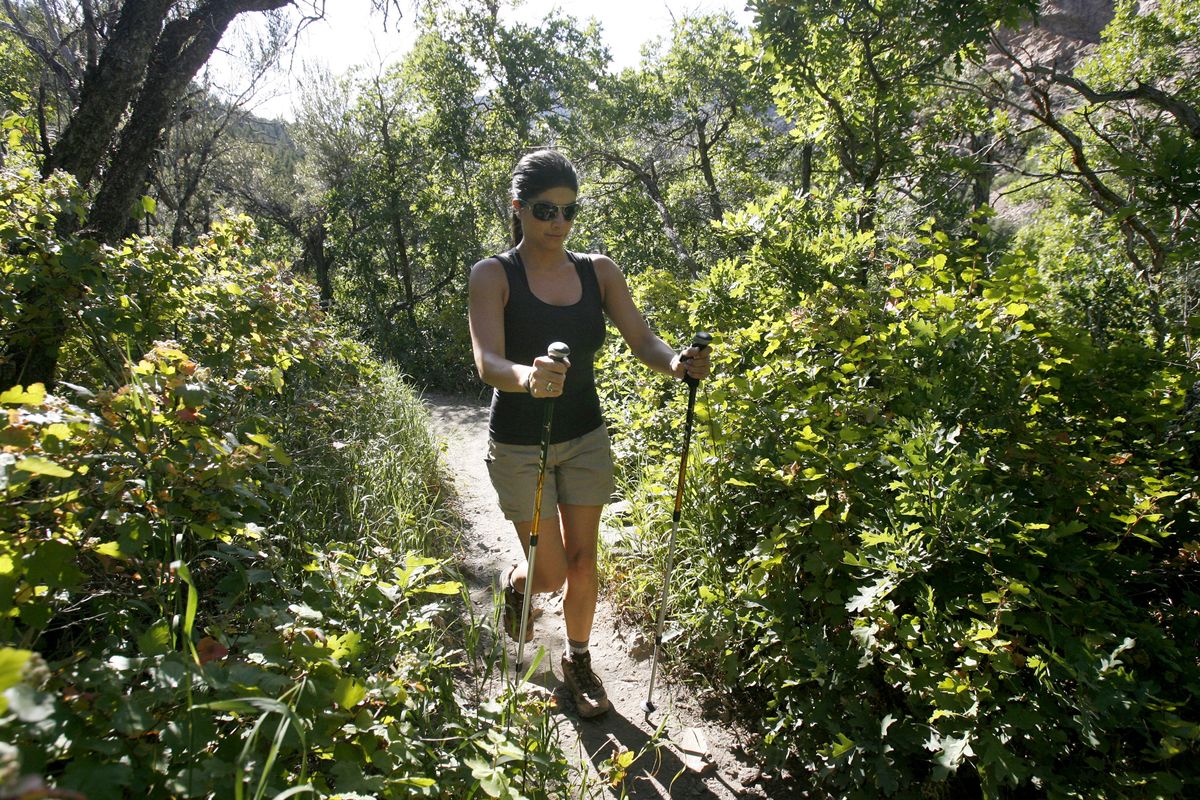Modern aids help hikers trek longer, faster, farther than before

You’ve seen them charging down the red-rock trail – the posture and attitude of a runway model with elbows and two hiking poles flying. Oddly, it’s either pedal-to-the-metal extreme hikers or wizened, trail-wise geezers who seem to have adopted double-fisted pole walking.
That alone should give pause to those of us who eschew a high-technology approach to the outdoors. Could there be something to these carbon-fiber and aluminum abominations – besides another toy for equipment freaks?
Sticking to the trail: “Trekking poles give you two additional points of balance,” says Michael Heathfield, a hiking and climbing expert at REI in Salt Lake City. “The upper body can assist you once you get used to them and add them to the rhythm of your stride. And it can become an upper-body workout.”
And that’s on flat trails. Adjustable and impact-absorbing poles offer additional benefits in climbing and descending steep grades.
“You can lengthen the poles on the downhill,” says Heathfield. “They can actually reduce impact on your joints up to 30 percent – and you’ve got two more points of balance coming down on a steep hill.”
Christine Schnitzer, who teaches nordic walking and represents outdoors companies that are trying to reach the 50-plus market, compares the rubber-tipped nordic poles to a road bike and trekking poles, with carbide metal tips, to a mountain bike.
“Trekking poles bring power to your uphill climbing, one can be very energetic going uphill,” Schnitzer says. “Many people become very interested in trekking poles when they want to protect their knees when they come downhill. You extend the poles a little longer to reach out to the ground, and it slows and controls your momentum and takes some of the impact off the knees.”
Also, she says, “On the downhill, they help to keep people focused and they prevent falls. They bring a sense of awareness that the whole body is involved in the descent.”
Heathfield, who is 54 and wants to continue hiking and climbing as long as possible, has long made trekking poles part of his basic equipment.
“I’ve used them for decades. From Day One they have been an advantage,” he says. “As I aged, I found them even more helpful. There’s nothing bad about them, and used correctly they are wonderful.”
It’s a new spin on the riddle of the Sphinx: “What goes on four legs in the morning, on two legs at noon, and on three legs in the evening?” Make that four legs, for evening hikes.
Monica Wells, 34, who hikes for recreation and exercise, is into her second set of hiking poles, having graduated from aluminum to the more shock-resistant carbon-fiber.
“I have a tough time with my knees as it is,” she says. “Instead of that harsh impact on the ground, the poles provide that cushion that makes it easier on your knees. I’m won over. I never hike without them.”
Gnarly knees only: About the only experienced hiker who has anything bad to say about hiking sticks is New Jersey-based Rick Bolger, and even he sees some good in them.
“There are times when these things will help people, particularly if it involves a medical situation – like a gnarly old knee,” he says. “I think the day is going to come when I will be hauling those things around myself. It’ll be a big irony.”
But for most hikers, Bolger believes poles are another case of technological overkill and consumerism run amok. He uses a 7-mile round-trip hike with a 2,000-foot elevation gain as an example: “That can be tiring, but I don’t think the majority of hikers need hiking sticks for that sort of thing.”
The trend in hiking poles, which is only beginning to be felt in the West, Bolger says, is driven by outdoor-retailer marketing.
“This whole country is about consumerism. People buy things because other people are buying them. Zip-off convertible trousers, funny-looking hats. Gray socks are in right now.
“A lot of people are going into the wilderness from suburbia. They think they need to have some sort of technology to take with them – it’s a self-defense thing. They end up spending a fortune for a 4-hour hike.”
He says trails in the Northeastern states are heavily used and hikers with trekking poles just make matters worse. “They have these sticks flying all over the place. The rocks are scratched beyond belief,” he says.
“For the average day hiker they’re more effort than it is worth. They’re just one (actually two) more thing to carry,” he says, and a distraction from the purpose of hiking – to connect with nature.
Some critics argue trekking poles are unnatural – humankind left quadrupedal locomotion behind eons ago.
“This sounds harsh, but if hiking poles prevent a seriously damaging fall, that person was probably going to fall for another reason,” says Bolger.
“If the hiking pole is the thing keeping you from peril, you should be avoiding that peril.”
Schnitzer disagrees. “When humans only lived to be 32 years old, there was no need for this extra support,” she says. But now, hikers can hope to remain active into their 80s.
“Definitely for people who are active, who have been active and want to remain active, trekking poles really make a difference,” Schnitzer says. “Hiking poles are a nice addition to the rest of my life. I hope to be hiking until I’m 90.”